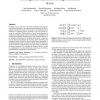Free Online Productivity Tools
i2Speak
i2Symbol
i2OCR
iTex2Img
iWeb2Print
iWeb2Shot
i2Type
iPdf2Split
iPdf2Merge
i2Bopomofo
i2Arabic
i2Style
i2Image
i2PDF
iLatex2Rtf
Sci2ools
POPL
2010
ACM
2010
ACM
Reconfigurable asynchronous logic automata: (RALA)
Computer science has served to insulate programs and programmers from knowledge of the underlying mechanisms used to manipulate information, however this fiction is increasingly hard to maintain as computing devices decrease in size and systems increase in complexity. Manifestations of these limits appearing in computers include scaling issues in interconnect, dissipation, and coding. Reconfigurable Asynchronous Logic Automata (RALA) is an alternative formulation of computation that seeks to align logical and physical descriptions by exposing rather than hiding this underlying reality. Instead of physical units being represented in programs only as abstract symbols, RALA is based on a lattice of cells that asynchronously pass state tokens corresponding to physical resources. We introduce the design of RALA, review its relationships to its many progenitors, and discuss its benefits, implementation, programming, and extensions.
Computer Science | Devices Decrease | POPL 2010 | Programming Languages | Reconfigurable Asynchronous Logic |
| Added | 29 Sep 2010 |
| Updated | 29 Sep 2010 |
| Type | Conference |
| Year | 2010 |
| Where | POPL |
| Authors | Neil Gershenfeld, David Dalrymple, Kailiang Chen, Ara Knaian, Forrest Green, Erik D. Demaine, Scott Greenwald, Peter Schmidt-Nielsen |
Comments (0)

